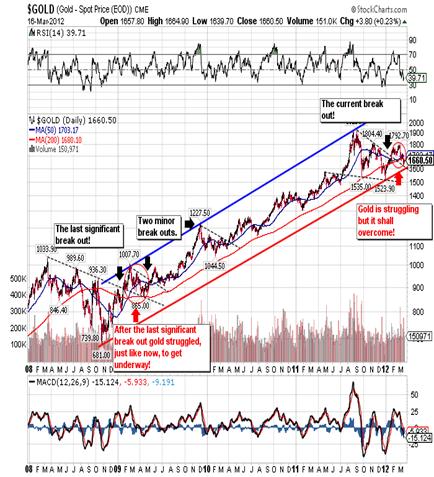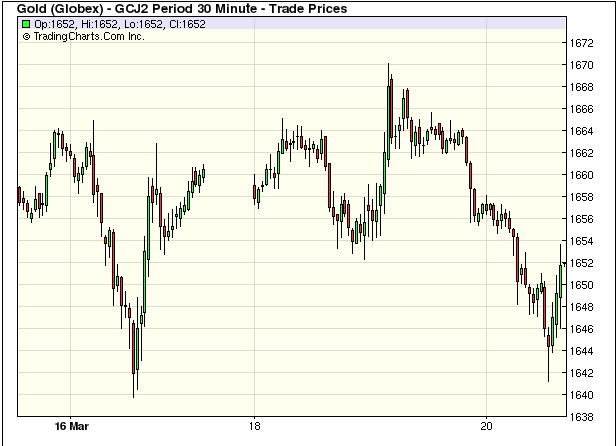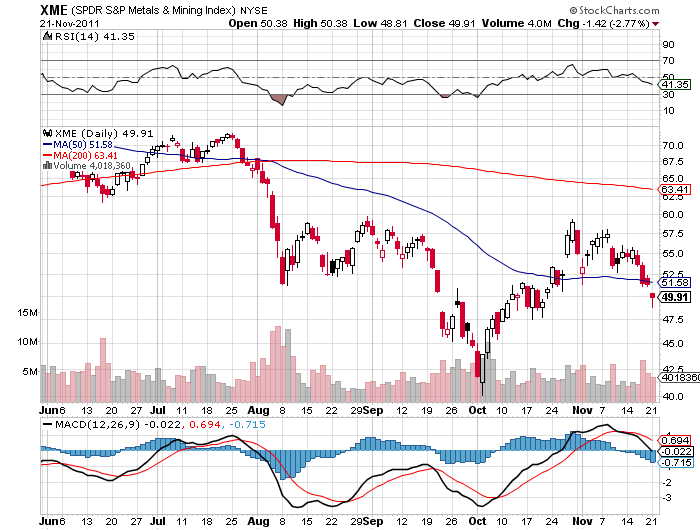Stocks & Equities
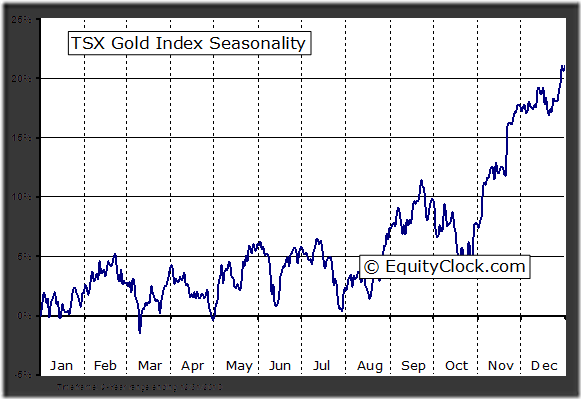
The PDAC Curse continues! Canadian gold equities have a history of moving higher from the last week in December until the third week in February in anticipation of encouraging news to be released just before or during the annual Prospectors and Developers Association Conference in Toronto early in March. Thereafter, Canadian gold equities tend to move lower. They followed their seasonal pattern once again this year. The TSX Gold Index from its low on December 29th to its high on February 23rd gained 13.4%. Subsequently, the Index plunged 13.4% by this Wednesday to reach a 20 month low. Moreover, next major support for the Index on the charts is 14% below current levels.
Weakness in gold equities this week is related to a $US68 per ounce plunge in the price of gold from last Friday to this Wednesday. On Wednesday, gold fell below its 200 day moving average at $1,679, a technical level that previously had provide strong support. Gold was responding partially to strength in the U.S. Dollar following news that U.S. Non-farm Payrolls in February continued to recover from depressed levels. The U.S. Dollar also strengthened following encouraging news from the Federal Reserve on Tuesday confirming slow, but steady economic growth in 2012. The Federal Reserve also noted its intention to maintain an easy money policy until the end of 2014.
The TSX Gold Index did not respond well to the news. Weakness in the Gold Index was the main reason why the TSX Composite Index dropped sharply on Wednesday when major U.S. equities indices were reaching multi-year highs. Moreover, prospects for gold and gold stocks are not encouraging between now and November 6th, the day when the next U.S president is elected. The U.S. Dollar has a history of moving higher between the end of March and the end of October during a U.S. Presidential election year. Not surprising, gold and gold stocks have a history of moving slightly lower during this period. Normally, gold and Canadian gold stocks have a period of seasonal strength from the end of July to the end of September followed by a second period of strength from the beginning of November to the third week in February. The latter period is likely to be the better period for re-entering the gold trade this year.
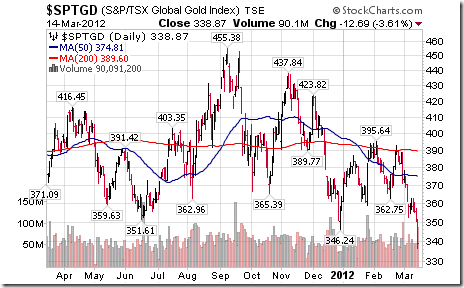
Preferred strategy is to look for better opportunities than gold and gold equities between now and November. Silver, platinum and their related equities are preferred over gold if your investment focus is on precious metals. Silver and platinum benefit from a growing demand for industrial purposes and have a history of outperforming gold between now and May..
The Gold Bugs Index fell another 33.44 points (6.56%) last week. It broke support at 477.93 to confirm an intermediate downtrend. Strength relative to gold remains negative.
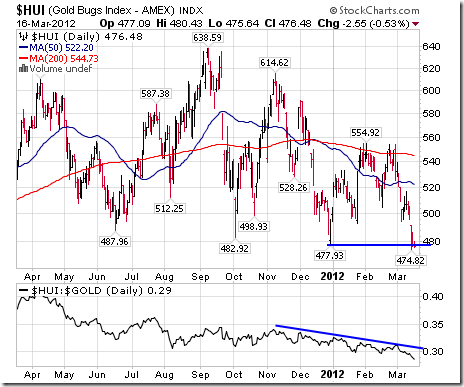



GOLD – ACTION ALERT – BUY
Continue to look to take delivery of the physical metals on further weakness. The gold/silver snake is coiling. The ‘gangsters’ at the Plunge Protection Team, JP Morgan Chase, and the CME will do their best to drive prices lower, but will get ‘bit’ by a venomous and revengeful market. There will be no tears here.
Gold and silver were recently knocked down to distract from the Greek bond default and that there is a huge movement away from the U.S. dollar as a trade settlement currency. The United States is waging economic nuclear war against Iran and threatening to do the same against India and is likely to suffer similar counterattack against its own vulnerabilities, and a lot more.
We may have hit support levels in both gold and silver, but I am awaiting further confirmation that lows are in place. Such lows may only be trading lows. Recall, we’ve entered a negative ‘seasonal’ time of year for gold and silver that could carry into the summer. There is, however, the possibility of another shot higher into May, but I would hope upside volume would confirm the advent of that move. Except for those of us who are long-term holders or for those who have no positions whatsoever, there is nothing to do here without a renewed upside trigger.
I urge you to subscribe to my VR Gold Letter for much greater detail at www.vrgoldletter.com. Call our office, we can offer you a discount for subscribing to more than one service.
For now, I am as psychologically prepared to see silver at 20 as to see it at 60 in the next twelve months. The big numbers for silver are 26 support and 37.60 resistance. The big numbers for gold are 1521 support and 1792 resistance – above which we could see 2500. As Ed Hart used to say on the old Financial News Network in the 1980s, ‘we will know in the fullness of time’.
VRTRADER.COM Trial Signup:
THE RENEWAL OF YOUR SUBSCRIPTION IS AUTOMATIC. YOUR CREDIT CARD WILL CONTINUE TO BE BILLED UNLESS YOU NOTIFY VRtrader.com SEVEN DAYS PRIOR TO SUBSCRIPTION EXPIRATION EITHER VIA EMAIL POSTING THE WORD ‘UNSUBSCRIBE’ IN THE SUBJECT BOX OR TELEPHONE US AT (928) 282-1275 OF CANCELLATION. NO REFUNDS ARE AVAILABLE ON SILVER, PLATINUM OR VR FORECASTER (ANNUAL FORECAST MODEL) SUBSCRIPTIONS.
Welcome and congratulations on choosing VRTrader.com as a source for your stock market commentary, information and analysis for the U.S. Stock Market. Needless to say we are very happy that you are joining us for AT LEAST the next 30 days days and look forward to providing you rewarding and inciteful information that will help you toward your goal of succeeding in the markets.
Here is the Special Trial Offer: Use this month to kick our tires. Pay 50% for the first 30 days (No refund) and sample our Silver or Platinum service and then decide what works best for you. If you aren’t 100% ready to move forward, simply email us to cancel one week before your 30 day 50% off trial subscription ends and it will be canceled and you will not be charged ANY FURTHER, no questions asked. Just send an email to mark.vrtrader@gmail.com” data-mce-href=”mailto:mark.vrtrader@gmail.com“>mark.vrtrader@gmail.com or call 928-282-1275 to cancel. You will receive an emailed confirmation of your cancellation at that time.
The 30 day trial is allowed one time only. By taking this 30 day 50% trial, you agree to be charged the full cost of the monthly Silver or Platinum service (choose one only) at the end of the 30 day trial subscription period, unless you cancel first. The regular Silver monthly rate is $49.40 and the Silver quarterly rate is $133.50. The regular Platinum monthly rate is $129.95 and the Platinum quarterly rate is $350.85. The special trial 50% off trial rates are listed below. Sign up today!
There are no refunds or pro-rata refunds offered at VRTrader.com for any subscription. You are being offered a 50% discount for trying our service for the first 30 days only!

Some companies in the oil and gas business get more appreciation in the market than they perhaps deserve. Others labor away building their assets and cash flow with little market recognition. In this exclusive interview with The Energy Report, Josh Young, founder and portfolio manager of Young Capital Management, brings us up to date on several of his favorite undervalued plays and talks about his newest discovery, which he believes to be an amazing value.
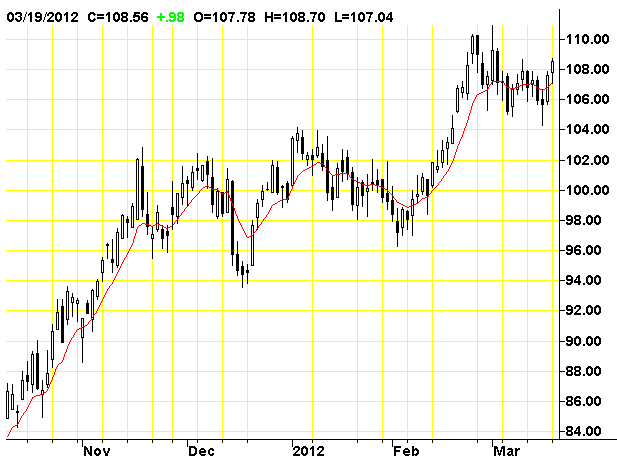
The Energy Report: When we last spoke three months ago, West Texas Intermediate (WTI) crude was trading at around $98 per barrel (/bbl). Since then we’ve had a spike up for a combination of reasons. Do you think that all the talk of $5 per gallon (/gal) gasoline is real or just hype by oil companies and traders; and where would the oil price need to go for $5/gal gas to become a reality?
Josh Young: Five-dollar/gal gas is a real possibility as prices are linked to the price of oil, which now seems to be driven by tight supply and demand dynamics. We saw that recently when there was an apparently false news report that a pipeline in Saudi Arabia had been blown up, affecting a couple of million barrels a day. Oil spiked $2 in the space of 15 minutes, despite the fact that the report was false. When that kind of news can cause that amount of price movement in that amount of time, it indicates that there really isn’t a lot of available capacity in the event of production shortage. Supply and demand are matched pretty tightly. On the flip side, the economy is still pretty weak and high oil prices produce some demand destruction. These are two big factors that are just barely counterbalancing each other.
TER: Do you think there’s some resistance around $110/bbl oil or can the price just shoot up astronomically?
JY: It really depends upon the scenario. I think things should be somewhat in balance around current prices, but if there is a bad economic crash, prices could come down potentially to $70 or $80 or even lower as they did in ’08 or ’09. If you see a big shock like a bombing in Iran for example, prices can spike.
TER: This being an election year, if oil prices go much higher, do you think President Obama might release supplies from the Strategic Petroleum Reserve to cool down the markets?
JY: If the U.S. or Israel bombs Iran, that obviously would be a consideration, and I wouldn’t be surprised if that happened. I would be surprised if there would be a release of those petroleum reserves in the absence of a world event along the lines of a major supply disruption.
TER: With these higher oil prices, many players in the oil business are benefitting. What has been the general market performance for the whole industry group since we last spoke?
JY: I read a recent Wall Street Journal article addressing that issue, and it reported that price performance of stocks of publicly traded oil and gas companies had not followed the price performance of oil. Looking down market, smaller-cap stocks have actually moved a lot less than larger-cap stocks. It seems investors are using larger stocks to track the price of oil. The preference for liquid stocks and larger companies has left behind some of the smaller companies that I tend to focus on. There hasn’t been the kind of across-the-board movement that one might expect with higher oil prices. Therein lies the opportunity; the longer oil prices stay high, the more likely there will be a small-cap oil stock rally.
TER: Can you bring us up to date on some of your favorite names that we discussed in the past?
JY: Sure. Gastar Exploration Ltd. (GST:NYSE) just reported that it is now producing approximately 1,000 barrels per day (bpd) of condensate and natural gas liquids (NGLs) in West Virginia. And that’s up from almost no oil production this time last year. It seems Wall Street is just starting to see the value here—almost every analyst covering the stock had higher than market price targets and reiterated their buy ratings after the recent news.
Gastar has drilled only a fraction of the locations it will be able to drill in West Virginia, has been adding acreage at a reasonable cost and has about $100 million (M) of capital available on its bank line, which it hasn’t drawn much of yet. So it’s borrowing money at 4–5% interest to drill wells that are generating in excess of 40% rates of return. Having shown that it can grow in a cost-effective manner without stock dilution, I think the company will start to attract more attention. It seems that Gastar offers investors a more cost-effective way to get Marcellus exposure, natural gas price leverage and oil production growth than larger companies, such as Cabot Oil & Gas Corp. (COG:NYSE), EQT Corp. (EQT:NYSE) and Range Resources Corp. (RRC:NYSE).
TER: Is that reflected in the price?
JY: Absolutely not. Gastar has been drilling these excellent wells in West Virginia, growing its production, and proving up the value of an asset that is worth a multiple of what the whole company is trading for, yet the stock has been drifting lower. Also, Encana Corporation (ECA:TSX; ECA:NYSE)drilled a well adjacent to Gastar’s East Texas properties that came on at an initial production rate of 750 bbl/day. That well’s production flattened out at about 250 bbl/day, which is very exciting. There is the potential that Gastar is right in the middle of a highly economic oil shale play. Gastar’s West Virginia Marcellus play is worth roughly $5 per share. If the East Texas oil play and the recently announced new mid-continent oil play work out, there could be substantial upside to $5, versus a recent stock price of ~$2.75.
TER: How about some of the other companies you’ve been following?
JY: Molopo Energy Ltd. (MPO:ASX) is another company I’ve talked about before. The stock is still stuck in a morass, despite an exciting deal in the works. Its CEO has been telling investors that he expects an ongoing asset sale process that the company has been involved with in Queensland, Australia to close in March. There are a number of reasons to expect a high sale value for the Australian asset. The price of liquid natural gas (LNG) in Japan, which is the primary market for Australian natural gas, has seen prices as high as $18 and $20 per thousand cubic feet (mcf). A nearby competitor in Queensland recently announced an offer that would imply a very high value for Molopo’s assets—as much as $150–200M. I don’t expect the assets to sell for quite that much, but could come in at a higher price than people expected.
TER: Where is that stock trading these days?
JY: Molopo trades around $0.70, with a market cap of around $150M. The company has $100M in cash, no debt and is currently producing net around 500 bbl/day. Combining the current production value plus its cash, you get everything else for free. It could easily sell the Queensland asset for $80M, plus it has development locations across 20,000 net acres in the Permian basin and a potential Bakken play on 50,000 net acres in southeast Saskatchewan. Analysts covering the stock estimate its value at $1.00-1.50.
TER: What about some of the other ones we talked about?
JY: Another company we’ve talked about is Sonde Resources Corp. (SOQ:NYSE). It’s a Canadian oil and gas company with an oilfield offshore North Africa. Sonde hired Bank of America Merrill Lynch to sell or joint venture its offshore North Africa assets. The local political situation is still a mess, but international oil companies seem to have acclimated to the situation. There are a lot of unstable countries where companies drill for oil and pay high valuations for reserves in the ground. Management has guided to a sale value of the North Africa assets of $2-5 per recoverable barrel of oil in the ground, which could yield $140-350M, versus the company’s current market cap of $150M. Sonde sold another asset recently and it’s sitting on $50M net cash. There’s a lot of opportunity to deploy that cash if oil prices fall or there is some sort of economic crisis. The CEO is excellent. He’s led other very successful oil and gas companies, including a position as co-CEO for Samson Investment Co, which was bought out for over $7B last year.
TER: Do you have any other companies worth talking about?
JY: I’ve recently found a very attractively priced, rapidly growing oil company, Gale Force Petroleum (GFP:CVE). Gale Force is trading at a 50+% discount to its Proved Developed Reserve value, is growing production by roughly 300% per year and has a small debt load. I invested in the company in a private placement, in addition to buying stock in the open market, and was retained as an advisor to help identify new deals and advise on hedging strategies and capital structure. Gale Force’s micro-cap peers typically trade for their PV-10 value, and in many cases they trade for many times their PV-10 values. The potential for that valuation uplift is part of what attracted me to the situation.
Gale Force’s market cap is only $12M, it has $6M of debt, over 300 barrels oil equivalent per day (boe/d) production and management believes they’re on track to produce 600 boe/d in September and 1,000 boe/d by the end of the year. And that’s over 80% oil, with the rest liquids-rich gas. I’ve looked extensively and have not found any other companies or assets where you can buy flowing barrels of oil with an exit rate implying a $20,000 per flowing bbl price. It has already achieved tremendous growth, from under 100 boe/d a year ago, to 300 boe/d now. Yet it is still under the radar and the company hasn’t been actively marketing its stock, preferring to focus on deal execution and property level operations. But as Gale Force grows production, people will start to pay attention. Even if no one ever cares about the stock, when the company grows to 1,000 boe/d, someone could come along and pay the industry standard of $100,000 a flowing bbl and you could see Gale Force being bought at the end of the year for a $100M. Other rapidly growing oil companies with similar size production have much higher valuations per flowing barrel—Voyager Oil & Gas Inc. (VOG:NYSE.A) produced approximately 420 boe/d last quarter and currently has a $180M market cap and Samson Oil & Gas (SSN:NYSE.A; SSN:ASX) produced 315 boe/d last quarter and has a $225M market cap. While not a perfect comparison, Gale Force is trading for roughly 1/10 of the value of those companies on a flowing barrel basis.
TER: Where is its production?
JY: It’s primarily in East Texas and some in South Texas. Gale Force also recently did a deal in the Marcellus, funding the development of non-operated working interest right next to Gastar. My fund and an energy private equity fund financed most of the deal, and Gale Force took the rest. So far so good, as the Marcellus wells are producing twice the condensate and NGLs as we were expecting.
Gale Force Petroleum’s growth opportunity and main business focus is in East Texas. It buys and operates underperforming fields, typically producing anywhere from 10 to 50 bbl/day. It reworks wells, increases their production, drills infill wells and then does it over again. Gale Force recently announced its next two acquisitions and should be up to 10 properties soon. It has a lot of production and is actually cash-flow positive.
Most similarly sized companies have high production decline rates, whereas Gale Force’s production is pretty flat because these are conventional wells with shallow decline rates, allowing Gale Force’s production to be more predictable, and for cash flow to be deployed for growth rather than to replace rapidly declining production. Gale Force has been able to achieve growth similar to shale players, but with mature assets at a fraction of the capex, and in my opinion with substantially lower risk. I get the best of both worlds—lower risk and rapid growth. As more investors discover Gale Force and as it delivers on production and executes operationally, I expect the valuation to improve substantially.
TER: That’s what people are looking for. Maybe this will be the next big winner. Any final thoughts you’d like to leave us with?
JY: I think there are interesting opportunities among small-cap oil and gas companies. And the smaller you can go, assuming the company is solvent and growing, and the more undervalued you can go, the higher the potential return and the lower the fundamental risk. And with high oil prices, perhaps that potential return is forthcoming.
TER: Thank you, Josh. We appreciate your insights.
Josh Young is the founder and portfolio manager of Young Capital Management, LLC, which launched Young Capital Partners, LP in 2010. He previously served as an analyst at Karlin Asset Management, a multibillion-dollar single-family office in Los Angeles. Prior to that, he was an investment analyst at Triton Pacific Capital Partners. He was also a corporate strategy consultant at Mercer Management Consulting and DiamondCluster. He holds a Bachelor of Arts in economics from the University of Chicago.



